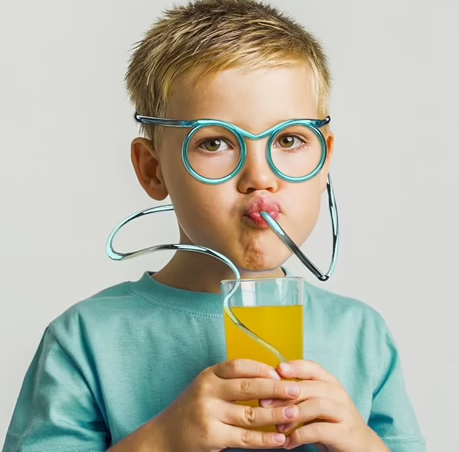Straws vs Sippy Cups: How Straws Support Speech, Feeding, and Oral Motor Skills
Straws are a great tool to help with your child’s oral motor development. They engage the muscles of the mouth and face, aiding in oral motor development, breath control, and feeding. Drinking through a straw can improve a person’s lip seal, tongue retraction, cheek strength, and jaw grading, all of which are important for clear speech and feeding.
From a sensory perspective, sucking can also help some individuals organize, increase his/her attention, and calm. Using straws for blowing or sucking helps to develop breath control and strengthen the diaphragm, which is important for speech production. These are all reasons why speech therapists and occupational therapists often use straws during feeding therapy and oral motor therapy.
Did You Know There Is a Correct Way to Use a Straw?
Only ¼ of an inch of the tip of the straw should enter your mouth! Yes, that’s right. The tip of the straw should stop at your front teeth and be in the center of your lips. You should be using slightly rounded lips and your mouth is only slightly open. Your tongue should be free to move up in order to aid in suction and swallowing.
Teaching children this proper straw drinking technique can support safer swallowing and more efficient oral motor patterns.
Why Straws Are an Excellent Alternative to Sippy Cups
Straws are an excellent alternative to sippy cups.
The action of sucking through a straw encourages better coordination of the mouth muscles, proper lip closure, and improved tongue strength and positioning compared to a sippy cup. Despite the benefits of using a straw, kids often use straws the same way they use a sippy cup. They put a large portion of the tip into their mouth, thus overly widening their jaw. They use flat lips on the tip and do not round them. Finally, their tongue is trapped under and/or around the tip of the sippy cup which results in the tongue moving forward and backward in order to draw the liquid out of the cup.
These habits can impact oral motor development, feeding skills, and even later speech sound production, which is why many pediatric therapists recommend transitioning from sippy cups to straws.
Transitioning from a Sippy Cup to a Straw
In order to transition from a sippy cup to a straw and use the straw appropriately, a child has to learn a new oral motor pattern. This involves retracting the tongue in the mouth and moving some part of the tongue to the roof of the mouth in order to create suction. It is suction which is necessary to draw the fluid into the mouth. Then the person has to control the fluid once inside his/her mouth.
Caregiver coaching from a speech therapist or occupational therapist can help break down these steps and make the transition from sippy cup to straw easier and safer.
Straws Are Beneficial, but the Type of Straw Is Important
Straws are beneficial, but the type of straw is important!
For example, a thick straw might be easier for a child to use who has weak lips. As the child’s lips get stronger, they can slowly transition to a smaller diameter straw. Straws that have a lot of twists and turns in them require a stronger amount of suction to use. This is because the twists and turns make the straw longer. The longer the straw, the greater the amount of suction is needed to use it. As a result, older kids usually do better with these types of straws.
Choosing the right straw based on a child’s age, strength, and oral motor skills is an important part of therapy.
Using Straws in Speech and Feeding Therapy
Overall, replacing sippy cups with straws can be a practical and effective step in developing oral motor skills and feeding during therapy, if the straw is used correctly. Using straws in therapy allows for targeted exercises to strengthen specific muscles, develop coordinated movements, and address issues related to speech, swallowing, and feeding.
A speech therapist or occupational therapist can select the appropriate type of straw based on an individual’s age, abilities, and therapy goals. If you have concerns about your child’s feeding, swallowing, or speech, talk with a pediatric speech therapist or occupational therapist for an individualized plan.
Resources
-
https://www.arktherapeutic.com/blog/the-oral-motor-benefits-of-straws/
-
(The) Beloved Sippy Cup Comes Under Attack. Eig, J., (2002, February 13). The Wall Street Journal. http://www.wsj.com
-
Straws As Therapy Tools. Rosenfeld-Johnson, S. (1999). http://www.advanceweb.com/







